-
Rebels Overrun Government Troops in Eastern DRC; Thousands Displaced, Including Virunga’s Gorilla Rangers
›October 29, 2008 // By Rachel Weisshaar Renegade General Laurent Nkunda’s fighters seized Virunga National Park headquarters at Rumangabo on Sunday, overtook the town of Rutshuru yesterday, and continue to advance on the regional capital of Goma, facing little resistance from either Congolese government troops or MONUC, the UN peacekeeping force. Thousands of local residents have fled the fighting, including 53 gorilla rangers who were in the park when it was taken by Nkunda’s rebels. Twelve of the rangers made it back to the relative safety of Goma today, after more than two days dodging bullets in the forest with no food or water, but the rest remain missing. Almost nothing is known about the condition of the park’s mountain gorillas, which represent half of the world population of 700.
Renegade General Laurent Nkunda’s fighters seized Virunga National Park headquarters at Rumangabo on Sunday, overtook the town of Rutshuru yesterday, and continue to advance on the regional capital of Goma, facing little resistance from either Congolese government troops or MONUC, the UN peacekeeping force. Thousands of local residents have fled the fighting, including 53 gorilla rangers who were in the park when it was taken by Nkunda’s rebels. Twelve of the rangers made it back to the relative safety of Goma today, after more than two days dodging bullets in the forest with no food or water, but the rest remain missing. Almost nothing is known about the condition of the park’s mountain gorillas, which represent half of the world population of 700. -
Prostitution, Agriculture, Development Fuel Human Trafficking in Brazil
›October 28, 2008 // By Ana Janaina NelsonModern-day slavery, also known as human trafficking, is the third most lucrative form of organized crime in the world, after trade in illegal drugs and arms trafficking. Today, 27 million people are enslaved—mostly as a result of debt bondage. The UN Office on Drugs and Crime (UNODC) report Trafficking in Persons: Global Patterns found that Brazil is the third-largest source of human trafficking in the Western hemisphere, after Mexico and Colombia. According to the U.S. Department of State’s Trafficking in Persons Report 2008, 250,000-500,000 Brazilian children are currently exploited for prostitution, both domestically and abroad. NGOs estimate that 75,000 Brazilian women and girls—most of them trafficked—work as prostitutes in neighboring South American countries, the United States, and Europe.
In addition, notes the Trafficking in Persons Report 2008, 25,000-100,000 Brazilian men are forced into domestic slave labor. “Approximately half of the nearly 6,000 men freed from slave labor in 2007 were found exploited on plantations growing sugar cane for the production of ethanol, a growing trend,” says the report. According to the International Labour Organization (ILO), the “agricultural states of the north, like Piaui, Maranhao, Pará and Mato Grosso, are the most problematic.” Agriculture and development have also been linked to sex trafficking. A 2003 study by the Brazilian NGO CECRIA found that in the Amazon, sexual exploitation of children often occurs in brothels that cater to mining settlements. The study also highlighted the prevalence of sex trafficking in regions with major development projects.
In response to growing awareness of the magnitude of this problem, the Brazilian Ministry of Justice has stepped up its efforts to combat human trafficking, adopting the ILO and UNODC’s “three-P” approach: prevention, prosecution, and protection. Prevention measures in Brazil focus on sexual exploitation, the most common type of forced labor for trafficked Brazilians. These measures include educating vulnerable populations about avoiding human trafficking, as well as drawing tourists’ attention to criminal penalties under Brazilian law for patronizing prostitutes.
Prosecution efforts in Brazil are also improving: In 2004, Brazil ratified the Palermo Protocol (pdf), the main international legal instrument for combating human trafficking. A year later, the country adopted a National Plan to Combat Human Trafficking, which aims to train those responsible for prosecuting traffickers and protecting victims—primarily police and judges. In addition, notes the Trafficking in Persons Report 2008:The Ministry of Labor’s anti-slave labor mobile units increased their operations during the year, as the unit’s labor inspectors freed victims, forced those responsible for forced labor to pay often substantial amounts in fines and restitution to the victims, and then moved on to others locations to inspect. Mobile unit inspectors did not, however, seize evidence or attempt to interview witnesses with the goal of developing a criminal investigation or prosecution because inspectors and the labor court prosecutors who accompany them have only civil jurisdiction. Because their exploiters are rarely punished, many of the rescued victims are ultimately re-trafficked.
The U.S. Department of State established a four-tiered assessment system to rate countries’ compliance with international trafficking mandates. In 2006, Brazil was listed on the Tier 2 Special Watch List, the second-worst rating, despite recognition that the government made “significant efforts” to combat human trafficking. Brazil recently moved into the Tier 2 category, however, due to more concerted interagency efforts, as well as greater compliance with international guidelines. Yet one wonders whether Brazil will be able to achieve Tier 1 status any time soon, given the Brazilian government’s focus on biofuel- and agriculture-fueled economic growth and the fact that the global financial crisis is likely to drive people into increasingly desperate economic straits.
By Brazil Institute Intern Ana Janaina Nelson.
Photo: A poster warns African women of the dangers of human trafficking; Brazilian women are subject to similar dangers. Courtesy of Flickr user mvcorks. -
Weekly Reading
›“[T]he careful management that helped make Alaskan pollock a billion-dollar industry could unravel as the planet warms,” warns Kenneth Weiss of the Los Angeles Times. “Pollock and other fish in the Bering Sea are moving to higher latitudes as winter ice retreats and water temperatures rise. Alaskan pollock are becoming Russian pollock, swimming across an international boundary in search of food and setting off what could become a geopolitical dispute.”
Poor rains, lack of infrastructure, and a shortage of skilled technicians have contributed to water-related disease and local-level water conflicts in Zimbabwe, reports IPS News.
If the Tripa peat forests in Sumatra continue to be cleared to make way for palm oil plantations, not only will the habitat of the critically endangered Sumatran orangutan shrink further, but millions of tons of CO2 will be released into the atmosphere, accelerating global climate change, reports the Telegraph.
A report on Somalia by the UN Food and Agriculture Organization says that one in six Somali children under the age of five is acutely malnourished and estimates that 43 percent of the country’s population will need humanitarian assistance through the end of the year. According to the report, poor rains, in addition to the worst levels of violence since 1990, have contributed to the humanitarian crisis.
“The number of tiger attacks on people is growing in India’s Sundarban islands as habitat loss and dwindling prey caused by climate change drives them to prowl into villages for food,” says an article from Reuters.
The current issue of the American Journal of Preventive Medicine (some abstracts available) focuses on the links between climate change and public health.
“Can Conservation Succeed with 9 Billion People?,” a panel at the recent Conservation Learning Exchange, was described as a “bang-up session” by Margaret Francis, who blogged about it. -
The New U.S. Army Field Manual on Stability Operations: Visionary Shift or Missed Opportunity?
›October 17, 2008 // By Will Rogers Last week, the U.S. Army released its new field manual on stability and reconstruction operations, FM 3-07, the 10-month interagency brainchild of the Army, State Department, and U.S. Agency for International Development (USAID). Some have hailed the doctrine as a fundamental shift in Army policy that recognizes the significance of non-military threats to U.S. national security, while others have criticized it as a missed opportunity to critically re-examine notions of what constitutes security.
Last week, the U.S. Army released its new field manual on stability and reconstruction operations, FM 3-07, the 10-month interagency brainchild of the Army, State Department, and U.S. Agency for International Development (USAID). Some have hailed the doctrine as a fundamental shift in Army policy that recognizes the significance of non-military threats to U.S. national security, while others have criticized it as a missed opportunity to critically re-examine notions of what constitutes security.
The new doctrine aims to shift the burden of fostering stability in fragile states from the Army to the State Department and USAID, which are better prepared to address non-military threats. To paraphrase Lieutenant General William Caldwell IV at an October 8, 2008, event sponsored by the Center for Strategic and International Studies: The Army is up against non-military threats that can cause widespread destabilization—such as, access to basic necessities like food, water, and shelter—and with its traditional mandate to win wars with overwhelming military force, the Army does not have the expertise to address these threats.
Instead, a new Civilian Response Corps under the State Department and USAID will receive crisis training from the Army to prepare for managing conflict scenarios. The Army hopes that this interagency effort will expand civilian agencies’ capacity to prevent instability from devolving into state failure, which increases the chances of the Army being deployed. Sustainability and human security are clearly viewed as ways to achieve stability and prevent costly military deployments, not as goals in and of themselves.
According to Geoff Dabelko, director of the Environmental Change and Security Program, it is important “to distinguish whether addressing sustainability needs is a tactic or a goal or both. It can be both for militaries but at times it is merely a tactic to achieve stability rather than a fundamental rethink of how security should be defined.”
Tad Davis, the Army’s deputy assistant secretary for environment, safety, and occupational health, recently said, with respect to military operations and access to water in Iraq, “You can get out there…and deploy to an area for conducting operations, but if water’s not there for drinking purposes and for cooking, showering, laundry, things like that, then you’re not going to be able to sustain the force.” Clearly, Davis views environmental sustainability as key to the Army’s operations, but not necessarily as a critical component of a lasting peace.
Yet others argue that the Army would be wise to adopt long-term environmental sustainability and human security as immediate goals, as they would reduce the frequency with which the Army is dragged into conflicts. Dabelko wonders whether the War on Terror might be more successful “if part of a diversified response to the attacks of 9/11 would have included an aggressive effort to address poverty as an underlying source of grievances around the world rather than having just a uni-dimensional strategy of use of force. The symbolic and the real impact of such a strategy might have been quite tangible.” Nonetheless, the Army’s recognition that security is broader than military force is a laudable step—hopefully not the last—in the right direction.Photo: Two Iraqi girls from Al Buaytha, Iraq, pump water from a U.S. Army-supplied portable water tank. Courtesy of flickr user James Gordon. -
A Roadmap for Future U.S. International Water Policy
› When I tell people I have been working on a report about U.S. international water policy, they usually respond with the same sardonic question: “The United States has an international water policy?” The answer, of course, is complicated. Yes, we have localized approaches to water challenges in parts of the developing world, and we have more than 15 government agencies with capacities to address water and sanitation issues abroad. And yes, the State Department and the U.S. Agency for International Development published a joint strategic framework this year for action on water issues in the developing world.
When I tell people I have been working on a report about U.S. international water policy, they usually respond with the same sardonic question: “The United States has an international water policy?” The answer, of course, is complicated. Yes, we have localized approaches to water challenges in parts of the developing world, and we have more than 15 government agencies with capacities to address water and sanitation issues abroad. And yes, the State Department and the U.S. Agency for International Development published a joint strategic framework this year for action on water issues in the developing world.
However, the U.S. government (USG) does not yet have an overarching strategy to guide our water programs abroad and maximize synergies among (and within) agencies. Furthermore, the 2005 Senator Paul Simon Water for the Poor Act—which calls for increased water and sanitation assistance to developing countries—has yet to be funded and implemented in a fashion that satisfies lawmakers. In fact, just last week, legislation was introduced in both the House and the Senate to enhance the capacity of the USG to fully implement the Water for the Poor Act.
Why has implementation been so slow? An underlying problem is that water still has no institutional home in the USG, unlike other resources like agriculture and energy, which have entire departments devoted to them. In the current system, interagency water coordination falls on a small, under-resourced (yet incredibly talented and dedicated) team in the State Department comprised of individuals who must juggle competing priorities under the broad portfolio of Oceans, Environment, and Science. In part, it is water’s institutional homelessness that hinders interagency collaboration, as mandates and funding for addressing water issues are not always clearly delineated.
So, what should be done? For the last year and a half, the Center for Strategic and International Studies’ (CSIS) Global Strategy Institute has consulted with policy experts, advocates, scientists, and practitioners to answer this million-dollar question. In our report, Global Water Futures: A Roadmap for Future U.S. Policy, we conclude that if we are serious about achieving a range of our strategic national interests, water must be elevated as a priority in U.S. foreign policy. Water is paramount to human health, agricultural and energy production, education, economic development, post-conflict stabilization, and more—therefore, our government’s organizational structure and the resources it commits to water should reflect the strategic importance of this resource.
Studies’ (CSIS) Global Strategy Institute has consulted with policy experts, advocates, scientists, and practitioners to answer this million-dollar question. In our report, Global Water Futures: A Roadmap for Future U.S. Policy, we conclude that if we are serious about achieving a range of our strategic national interests, water must be elevated as a priority in U.S. foreign policy. Water is paramount to human health, agricultural and energy production, education, economic development, post-conflict stabilization, and more—therefore, our government’s organizational structure and the resources it commits to water should reflect the strategic importance of this resource.
We propose the creation of a new bureau or “one-stop shop” for water policy in the State Department to lead in strategic planning, implementation, and evaluation of international water programs; mobilize resources in support of water programming overseas; provide outreach to Congress and important stakeholders; and serve as a research and information clearinghouse. This would require significant support from the highest levels of government, increased funding, and greater collaboration with the private and independent sectors.
The current economic crisis means we are likely to face even greater competition for scarce foreign aid resources. But I would argue—paraphrasing Congressman Earl Blumenauer at our report rollout—that relatively little funding toward water and sanitation can have a significant impact around the world. As we tighten our belts during this period of financial instability, it is even more important that we invest in cross-cutting issues that yield the highest returns across defense, development, and diplomacy. Water is an excellent place to start.
Rachel Posner is a research associate at the Center for Strategic and International Studies’ Global Strategy Institute.
Photo: Environmental Change and Security Program Director Geoff Dabelko and Congressman Earl Blumenauer (D-OR) at the launch of Global Water Futures: A Roadmap for Future U.S. Policy. Courtesy of CSIS. -
Lethal Rockslide in Cairo Slum Reveals Government’s Lack of Preparedness
›September 30, 2008 // By Lauren Herzer RisiEarlier this month, approximately eight boulders weighing 60-70 tons each split from the edges of the Muqattam cliffs and fell onto densely populated Manshiyet Nasr, a slum in eastern Cairo, killing more than 100 people and destroying 30-50 homes. By the next day, security officials outnumbered rescue workers in the area, and locals, outraged by the slow response of the government, were clashing with police. This tragedy and the ensuing conflict between residents and local authorities highlight the need for effective governance and urban planning to alleviate poverty and rapid urbanization and avoid conflict.
Rockslides are not uncommon in Manshiyet Nasr; in 2002, for example, 27 people were killed under similar circumstances in the same area. One local journalist reported that “the reason the rocks keep falling is because there is no sewage system and their wastewater is eating away at the mountain.” This lack of basic sanitation services is a common characteristic of the informal settlements and slums that are growing exponentially worldwide. This year, for the first time, more than half of the global population lives in cities; it is forecast that by 2030, 81 percent of the urban population will reside in the cities of developing countries, which are unplanned, underserved by services like sanitation, and unable to cope with continually growing demand for these services. The rockslide in Manshiyet Nasr is a stark example of what can happen when a city’s infrastructure and government are unprepared to deal with rapid urbanization and increasing poverty, and how these challenges are exacerbated by poor government response. (For more on Cairo’s informal settlements, see the Comparative Urban Studies Project’s Urban Studies in Cairo, Egypt.)
A recent Human Development Report analyzing Egypt’s progress toward attaining the Millennium Development Goals noted that the poverty rate in Cairo, a city of 16 million people, is expected to almost double between now and 2015. This growth in poverty is attributed to “increasing numbers of residents in vulnerable areas and increasing rates of internal migration.”
It is important to note, however, that migration alone does not account for increasing poverty. In Global Urban Poverty, a publication of the Wilson Center’s Comparative Urban Studies Project and the U.S. Agency for International Development, Loren Landau argues that “public responses to migration and urbanization—including the absence of a conscious coordinated response—have tended to exacerbate mobility’s negative effects on all of the Millennium Development Goals.”
The Egyptian government’s initial response to the rockslide in Manshiyet Nasr was to hold the residents accountable for living in an illegal settlement in a dangerous area. Yet 70 percent of Cairo residents live in informal communities like Manshiyet Nasr. In addition to a severe housing shortage and lack of urban planning, a history of slow government response to disasters is intensifying accusations of government neglect and incompetence.
Except for an 18-month break in 1980-81, Egyptians have lived under emergency law since 1967. This law prohibits public gatherings, restricts speech, permits searches without warrants, and enables the police to detain citizens without charge or trial. After promising to repeal the law during his 2005 presidential campaign, Hosni Mubarek, who has been in power since 1981, extended the law in 2006 and again in May of this year. While proponents of the law (and of Mubarek) claim that the state of emergency has helped stabilized the country, human rights groups argue that the law violates human rights and sanctions the government’s oppression of political rivals.
Egypt’s history of extreme law and unchecked police powers has stunted the development of a system of governance that responds to the most basic needs of Egyptians. Manshiyet Nasr residents’ angry reaction to the poor government response to the rockslide is evidence of their smoldering desperation. -
PODCAST – Virunga National Park and Conflict in the DRC
›September 11, 2008 // By Geoffrey D. Dabelko“The resource base is a point of contact for local residents, refugees, rebel groups, park rangers, [and the] military as they struggle to survive,” says Richard Matthew of the University of California, Irvine, in this podcast interview, describing the significance of Virunga National Park to the diverse collection of actors in the eastern Democratic Republic of the Congo. Matthew cites a fundamental tension between the needs of the park—which is home to some of the few remaining mountain gorillas in the world—and the desperate humanitarian needs of the people living in and around it. On a recent assessment trip to the area for the UN Environment Programme (UNEP), Matthew and his colleagues met with many of these groups to help find ways to reduce pressure on the park’s natural resources, while recognizing they are key to the livelihoods of millions of needy people in the region. I also asked Matthew to highlight some of the human security topics he and his colleagues pursue at the Center for Unconventional Security Affairs at UC Irvine. One such topic is microfinance. “Microfinance lending rarely takes into consideration the environmental impact and conflict-inducing impacts,” says Matthew. He and his colleagues are convening practitioners and conducting research on practical ways to “green” and reduce the conflict-generating impacts of this increasingly popular development strategy.
I also asked Matthew to highlight some of the human security topics he and his colleagues pursue at the Center for Unconventional Security Affairs at UC Irvine. One such topic is microfinance. “Microfinance lending rarely takes into consideration the environmental impact and conflict-inducing impacts,” says Matthew. He and his colleagues are convening practitioners and conducting research on practical ways to “green” and reduce the conflict-generating impacts of this increasingly popular development strategy.
I conducted this interview in a noisy UN cafeteria in New York City. We were both in town to meet with David Jensen and colleagues from UNEP’s Disasters and Conflicts Programme and the UN Peacebuilding Commission. Expect a podcast and article soon from Jensen on the New Security Beat and in the Woodrow Wilson Center’s Environmental Change and Security Program Report, respectively.
Photo: A charcoal checkpoint in Virunga National Park. Courtesy of Richard Matthew. -
Somalia Battered by Drought, Food Shortages, Worsening Violence
›September 5, 2008 // By Will Rogers “The humanitarian nightmare in Somalia is the result of a lethal cocktail of factors,” writes Ken Menkhaus in a recent ENOUGH strategy paper, Somalia: A Country in Peril, a Policy Nightmare,” launched this week at the Wilson Center (video). Menkhaus was joined by Chris Albin-Lackey, a senior researcher at Human Rights Watch, and Harun M. Hassan, a Somali journalist and writer based in Washington, DC, for a discussion of the political and humanitarian situation in Somalia, which is ranked first on the 2008 Failed States Index.
“The humanitarian nightmare in Somalia is the result of a lethal cocktail of factors,” writes Ken Menkhaus in a recent ENOUGH strategy paper, Somalia: A Country in Peril, a Policy Nightmare,” launched this week at the Wilson Center (video). Menkhaus was joined by Chris Albin-Lackey, a senior researcher at Human Rights Watch, and Harun M. Hassan, a Somali journalist and writer based in Washington, DC, for a discussion of the political and humanitarian situation in Somalia, which is ranked first on the 2008 Failed States Index.
The country has been plagued by “18 years of state collapse, failed peace talks, violent lawlessness and warlordism, internal displacement and refugee flows, chronic underdevelopment, intermittent famine, piracy, regional proxy wars, and Islamic extremism,” writes Menkhaus. Over the past 18 months, severe drought and increased attacks against relief agencies have left 3.2 million Somalis in dire need of humanitarian assistance. Two-thirds of Mogadishu’s population—700,000 people—has fled the city for Somalia’s harsh countryside, where they lack access to food, clean water, basic health care, livelihoods, and support networks.
Fighting between the Transitional Federal Government (TFG), Ethiopian troops, and regional militias has exacerbated food shortages, as TFG and Ethiopian troops target local markets, including the Bakaara market in Mogadishu, in retaliation for militia attacks. With drought “killing off livestock and reducing harvests in farming areas” and the economy crippled by violence and an outbreak of counterfeiting, food prices have skyrocketed.
Although Menkhaus rightly mentions a few of the situation’s environmental aspects, such as the drought’s role in the food crisis, he neglects the role population growth has played. The 2008 Failed States Index ranked Somalia as the state with the most demographic pressure – a significant indicator of state instability – (tied with Bangladesh). According to the Population Reference Bureau, Somalia has a total fertility rate of 6.7 children per woman and an annual rate of natural increase of 2.7 percent. With 45 percent of the population under 15, Somalia’s youth bulge increases the likelihood of continued violence; in addition, if Somalia ever does find peace and stability, its government will be hard-pressed to meet the needs of all its citizens for jobs, health care, and education.
Humanitarian agencies in Somalia have attempted to provide relief, but they face rampant extortion, corruption, and intimidation. According to Menkhaus, “uncontrolled and predatory TFG security forces, along with opportunistic criminal gangs, have erected over 400 militia roadblocks (each of which demands as much as $500 per truck to pass).” In addition, since May 2008, jihadist cells in Mogadishu operating under al-Shabaab, “a hardline military faction of the Islamist movement,” have stepped up attacks against relief workers and are assassinating “any and all Somalis working for western aid agencies or collaborating with U.N. and Western NGOs.”
Somali piracy has made humanitarian shipments to sea ports a treacherous task. According to Albin-Lackey, Somalia’s second-largest port, Kismaayo, fell to al-Shabaab militants last week after weeks of fighting between the Islamic group and TFG security forces, cutting off a crucial delivery point for humanitarian shipments. According to Menkhaus, with human insecurity worsening, Somalis who would not otherwise support fundamentalism will become more vulnerable to recruitment from criminal gangs and terrorist cells, including al-Qaeda. And although the Djibouti Accord was signed last month between the TFG and a faction of the opposition Alliance for the Re-liberation of Somalia, experts are pessimistic that it will do anything to end the violence.
Photo: Internally displaced people (IDPs) flee the escalating violence in Mogadishu for IDP camps on the outskirts of the city, where newcomers build their own makeshift shelters. Courtesy of Abdurrahman Warsameh and ISN Security Watch.
Showing posts from category humanitarian.


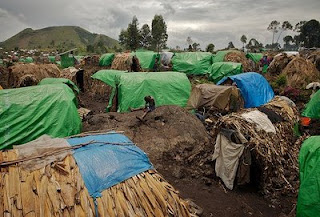 Renegade General Laurent Nkunda’s fighters seized
Renegade General Laurent Nkunda’s fighters seized 
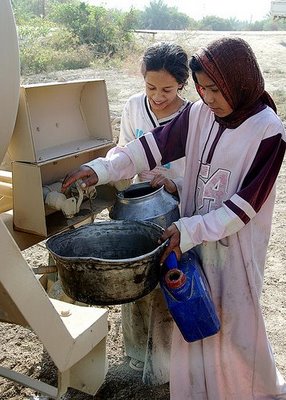 Last week, the U.S. Army released its new
Last week, the U.S. Army released its new 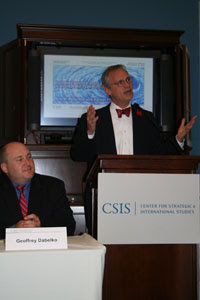 When I tell people I have been working on a report about U.S. international water policy, they usually respond with the same sardonic question: “The United States has an international water policy?” The answer, of course, is complicated. Yes, we have localized approaches to water challenges in parts of the developing world, and we have
When I tell people I have been working on a report about U.S. international water policy, they usually respond with the same sardonic question: “The United States has an international water policy?” The answer, of course, is complicated. Yes, we have localized approaches to water challenges in parts of the developing world, and we have 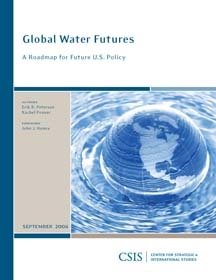 Studies’ (CSIS)
Studies’ (CSIS)  I also asked Matthew to highlight some of the human security topics he and his colleagues pursue at the
I also asked Matthew to highlight some of the human security topics he and his colleagues pursue at the 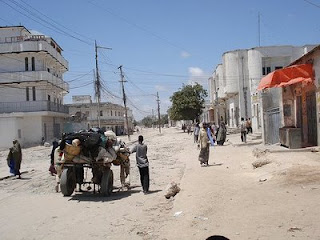 “The humanitarian nightmare in Somalia is the result of a
“The humanitarian nightmare in Somalia is the result of a 

